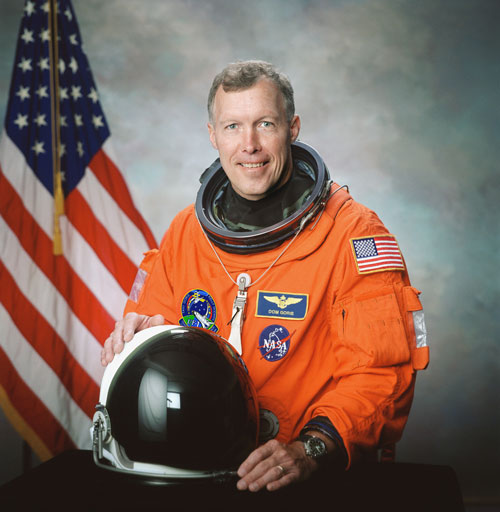STS-123 Commander: Dominic L. Gorie

NAME: Dominic L. Gorie (Captain, U.S. Navy, ret.)
NASA Astronaut
PERSONAL DATA: Born May 2, 1957, in Lake Charles, Louisiana. Married to Wendy Lu Williams of Midland, Texas. They have two children, Kimberly and Andrew. Dom enjoys skiing, bicycling, fishing, and hiking with his family.
EDUCATION: Graduated from Miami Palmetto High School, Miami, Florida, in 1975. Bachelor of Science degree in ocean engineering from the U.S. Naval Academy in 1979. Master of science degree in aviation systems from the University of Tennessee in 1990.
SPECIAL HONORS: Defense Superior Service Medal, Legion of Merit, Distinguished Flying Cross (2) one with Combat “V”, Defense Meritorious Service Medal, Joint Meritorious Service Medal, Air Medal (2), Space Flight Medal (3), Navy Commendation Medal with Combat “V” (2).
EXPERIENCE: Designated a Naval Aviator in 1981. Flew the A-7E Corsair with Attack Squadron 46 aboard the USS America from 1981 to 1983. Transitioned to Strike Fighter Squadron 132 in 1983, flying the F/A-18 Hornet aboard the USS Coral Sea until 1986. Attended the U.S. Naval Test Pilot School in 1987 and served as a Test Pilot at the Naval Air Test Center from 1988 to 1990. Then was assigned to Strike Fighter Squadron 87 flying the F/A-18 aboard the USS Roosevelt until 1992. Participated in Operation Desert Storm, flying 38 combat missions. In 1992 received orders to U.S. Space Command in Colorado Springs for two years before reporting to Strike Fighter Squadron 106 for F/A-18 refresher training. Was enroute to his command tour of Strike Fighter Squadron 37 when selected as an Astronaut Candidate.
Gorie has accumulated over 6000 hours in more than 35 aircraft and has over 600 carrier landings.
Gorie retired from the Navy in September 2005.
NASA EXPERIENCE: Selected as an astronaut candidate by NASA in December 1994, Gorie reported to the Johnson Space Center in March 1995. He completed a year of training and evaluation and then was initially assigned to work safety issues for the Astronaut Office. Gorie next served as a spacecraft communicator (CAPCOM) in Mission Control for numerous Space Shuttle flights, and was chief of the Astronaut Shuttle Branch. A veteran of three space flights, Gorie has logged over 32 days in space. He served as pilot aboard STS-91 in 1998 and STS-99 in 2000, and was the crew commander on STS-108 in 2001. Gorie is assigned to command the STS-123 mission that will deliver the Japanese Logistics Module and the Canadian Special Purpose Dexterous Manipulator to the International Space Station.
SPACE FLIGHT EXPERIENCE: STS-91 Discovery (June 2-12, 1998) was the 9 th and final Shuttle-Mir docking mission, concluding the joint U.S./Russian Phase I Program. The STS-91 mission was accomplished in 154 Earth orbits, traveling 3.8 million miles in 235 hours and 54 seconds.
STS-99 (February 11-22, 2000) was an 11-day flight during which the international crew aboard Space Shuttle Endeavour worked dual shifts to support payload operations. The Shuttle Radar Topography Mission mapped more than 47 million miles of the Earth’s land surface. The STS-99 mission was accomplished in 181 Earth orbits, traveling over 4 million miles in 268 hours and 38 minutes.
STS-108 Endeavour (December 5-17, 2001) was the 12th shuttle flight to visit the International Space Station. Endeavour’s crew delivered the Expedition-4 crew and returned the Expedition-3 crew. The crew unloaded over 3 tons of equipment and supplies from the Raffaello Multi-Purpose Logistics Module, and performed one space walk to wrap thermal blankets around ISS Solar Array Gimbals. STS-108 was accomplished in 185 Earth orbits, traveling 4.8 million miles in 283 hours and 36 minutes.
- NEW VIDEO: Danger on the Pad: Shuttle Astronauts Practice Escape Drill
- VIDEO: ESA's New Science Laboratory
- Complete Space Shuttle Mission Coverage
Get the Space.com Newsletter
Breaking space news, the latest updates on rocket launches, skywatching events and more!
Join our Space Forums to keep talking space on the latest missions, night sky and more! And if you have a news tip, correction or comment, let us know at: community@space.com.

The National Aeronautics and Space Administration (NASA) is the U.S. government agency in charge of the civilian space program as well as aeronautics and aerospace research. Founded in 1958, NASA is a civilian space agency aimed at exploring the universe with space telescopes, satellites, robotic spacecraft, astronauts and more. The space agency has 10 major centers based across the U.S. and launches robotic and crewed missions from the Kennedy Space Center in Cape Canaveral Florida. It's astronaut corps is based at the Johnson Space Center in Houston. To follow NASA's latest mission, follow the space agency on Twitter or any other social channel, of visit: nasa.gov.









